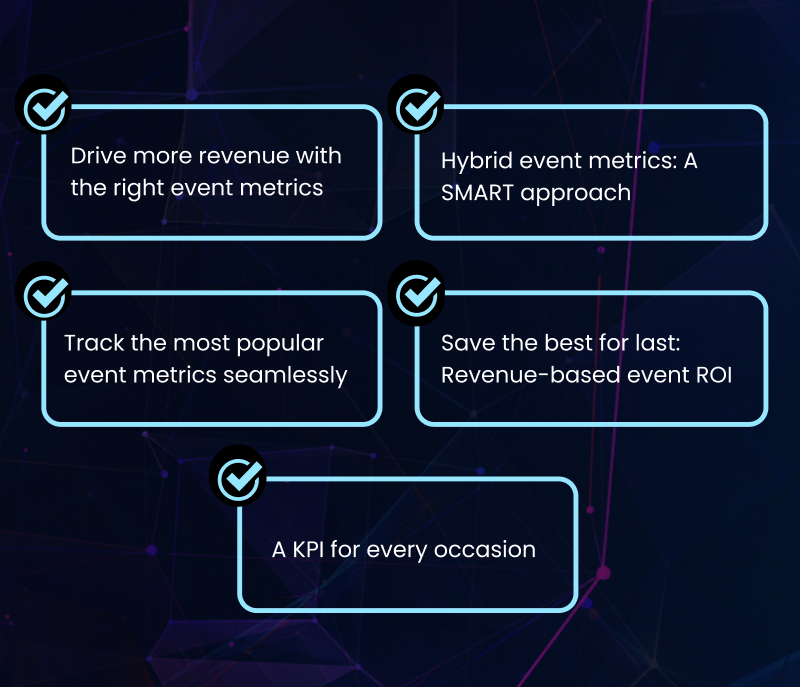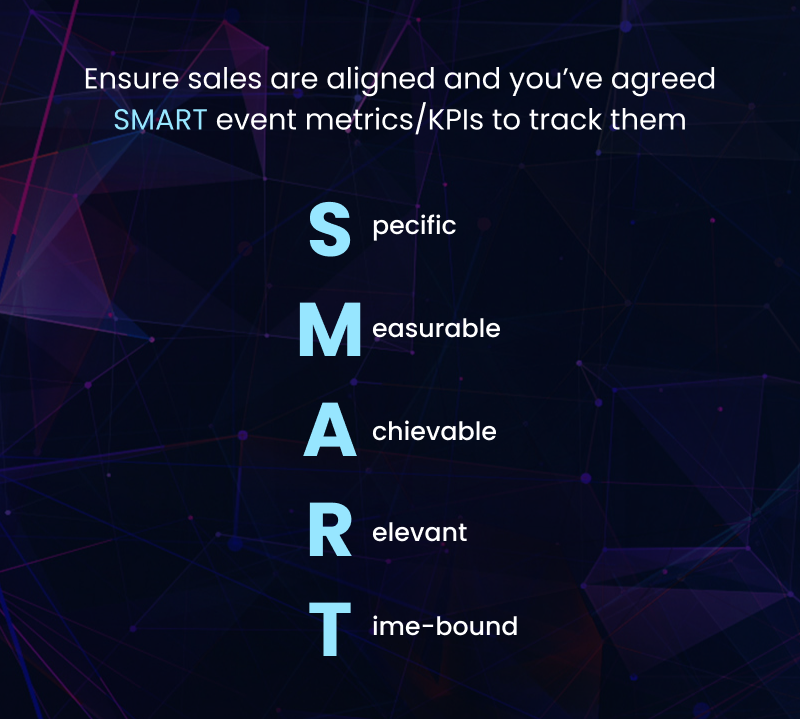Hybrid Event Metrics: What KPIs Should You Use to Measure Your Next Hybrid Event?

Table of Contents
Maximize Your Marketing ROI
Join 10,000 other marketers already getting the best tips on running engaging events that boost pipeline and create raving fans.
As we move into the post-pandemic era, hybrid events are set to dominate — offering the perfect chance for event marketers to get the praise they’ve long deserved, but have lacked the data to prove.
Because although we know what an awesome job you do, tracking event value through KPIs hasn’t been simple. Until now.
Field marketing in the world after 2020 is a numbers game — and the rise of hybrid events presents the perfect opportunity to introduce revenue-driven event metrics and prove just how much event marketing matters.
But measuring a whole new type of event isn’t easy.
This comprehensive guide covers everything you need to know to ensure your hybrid event is as awesome as you are, including why event KPIs are necessary, which ones to choose based on your unique event goals, and how to track your success using a killer event management platform.
Welcome to the age of hybrid events. Ready to rock? Let’s get started.


Drive more revenue with the right event metrics
If there’s one thing everyone cares about, it’s revenue.
Sales have claimed revenue attribution since the dawn of time (not to mention the internal praise and bonuses that go along with it). And while we know they wouldn’t be nearly as successful without marketing, it’s your job to prove that.
Marketing and sales alignment can increase annual revenue by 20%, so take that shared revenue objective and initiate a little sales and marketing synchronization to help boost those $$$.
How exactly?
By aligning on the core revenue-driven event metrics.
With next-level event data, your sales team can personalize their approach to follow-ups, leading to greater conversion levels and, in turn, revenue.
It’s time to show the rest of the team just how crucial field marketing really is.
Hybrid event metrics: A SMART approach
The definition of event success varies for everyone and is often dependent on specific event goals — but by using Key Performance Indicators (KPIs) to measure event success, you can drill down on the metrics that matter (and earn that all-important seat at the revenue table while you’re at it 😉).
But what are your company’s needs? Growth? Brand awareness? Customer loyalty?
Whatever your goals, ensure sales are aligned and you’ve agreed SMART event metrics/KPIs to track them:

Alignment is key. When it comes to event ROI, you’ll be left red-faced if you’ve focused on lead gen when everyone was expecting end of funnel conversion. 🤦
Track the most popular event metrics seamlessly
Now that you’ve chosen your event goals (and aligned them with sales’), it’s time to focus on the five most sought after event metrics.
Depending on your specific event goals, these hybrid event KPIs will help you collect the data you need to make money, forge relationships and improve future event performance.
So let’s take a look.
Hybrid event metric #1: Number of attendees
On average, 56% of hybrid event attendees join the in-person event and 44% attend the virtual version.
In other words, by only offering only one event type you’ll lose around half of your potential attendees.
The flexibility of hybrid events allows for more attendees. You can invite as many as you like to really boost those pre-event registration numbers (both virtual and in-person), for a stronger list of day-of attendees.⚽ Event goal: Have X registrants attend in person or live if attending virtually, for example.
Hybrid event metric #2: Brand awareness
When it comes to hybrid events, branding is everything.
In fact, 74% of event attendees say a branded event experience makes them more likely to buy the product.
Make use of the boost in attendance that hybrid events provide and really push your brand. For the in-person venue, think: signs, banners, color schemes, logos, swag, etc. While for the virtual side, think: a fully customizable, white label virtual event platform.
Remember the virtual side of the event should look and feel like your in-person event to create a seamless attendee experience from end-to-end.⚽ Event goal: Increase brand loyalty.
Hybrid event metric #3: Social press mentions
Social media mentions are essentially shout-outs from attendees on any social media platform. Event hashtags or handles allow you to track these with ease and get a qualitative feel for what attendees really think of your event. Make sure your handle and hashtag are everywhere: in pre-event communication, at the live event and on your customizable event platform.The number of mentions over the duration of your event can then be compared to other times in the year. The more mentions, the more engaged your audience is and the more likely they are to convert. Social media mentions are also a great qualitative KPI for tracking both brand awareness and lead generation goals, so you can see how many potential customers found your brand via the social buzz around your event.Here's why social media referrals are everything:
- Referred leads convert 30% better than lead gen channels.
- They have a 16% higher lifetime value.
- Their retention rate is 37% higher.
- And they’re 4X more likely to refer more customers.
⚽Event goal: Increase social media referrals by 30%.
Hybrid event metric #4: Amount of sales generated
A whopping 71% of event organizers rank closed-won opps as a success factor, so it’s clearly an important one — after all, if your company isn’t generating sales your ship will start sinking fast.
If your event is focused on leads at the end of the pipeline, then sales generated is going to be the most obvious proof of your hybrid event’s power to convert. In cases like this, sales generated is vital to track.
But sales generated as an event metric can be tricky for three reasons:
- Closed-won can take a while depending on the length of your sales cycle, and sometimes it can be L-O-N-G. If you need to produce an event ROI analysis quickly after your event finishes, this metric may not be available.
- Depending on your attribution method, your event may not even receive the kudos it deserves.
- If your goal is to generate a new pipeline, create brand awareness or nurture pre-existing customers, this event metric may be less relevant as it doesn’t focus on the outcomes your goals require.
⚽ Event goal: Close 10 leads or $100,000 pipeline potential.
As revenue-driven as sales generated is, you’re going to want something a little more data-led to add to your KPIs.
Hybrid event metric #5: Number of MQLs
Here’s where account-level insights become super important to your hybrid event ROI.
The number of MQLs gives deep, personalized insights to secure greater conversion from event follow-ups. And with an event management platform that integrates directly with your CRM, you can assign a lead score based on engagement levels and types.
To start, decide on what constitutes an MQL. It may be something as simple as anyone who presses the ‘Request a demo’ button in your virtual platform or speaks to a representative in a booth at the live venue. But it can also be less obvious and involve a holistic decision based on a variety of engagement factors. For example, you may assign a weighted score to:
- Clicks
- Polls answered
- Breakout rooms entered
- Sessions attended
- Booths visited
- Videos viewed
- In-person sales conversations
- Content downloaded
Karli Williamson, Senior Events Manager at Gremlin, believes this data-driven approach to high-quality MQLs is the only way. “We mapped out our scoring ahead of time. 25 points for this, 50 points for this… we're really particular about who crosses that MQL threshold,” she says.
When you use a virtual event platform to track qualified sales, you provide sales with warm leads and a bunch of relevant insights to go along with it.
For Karli, her sales team loved having information on:
- Which sessions leads’ attended
- The videos they watched
- Which questions they asked
- What interested them enough to want more resources
⚽ Event goal: Pipeline velocity — take 50 leads from net new to MQL.
Save the best for last: Revenue-based event metrics
Proving your event generated real revenue is undeniably the best KPI to aim for. Have you ever met a C-suite member who didn’t love the look of a dollar sign?
Here’s a super simple calculation to help prove your ROI:
Event Revenue / Event Expenses x 100For your event revenue figure, you can also opt to use the value of net pipeline generated, pipeline influenced or won.
With this formula, it’s also worth noting that hybrid events will have extra overhead compared to virtual. Here are just a few of the costs you’ll need to factor in:
- Physical branding materials
- Venue costs
- Catering
- Swag and printed agendas
- Onsite security
As your costs go up, you need to be able to calculate ROI efficiently, and understand how to increase it with every future event. This KPI helps you do exactly that!
Hint: Swapping even a portion of your in-person events to hybrid or fully virtual means you’re well on your way to slashing those overheads and smashing your event ROI.
⚽ Event goal: Improve revenue-based event ROI by 10%.
A KPI for every occasion
If success looks different at each event, you may need some deeper hybrid event metrics to help get a clear picture of what’s really going on.
To get you started, here are a few KPIs to consider, depending on your unique event goals:
Attendee KPIs
- Registration numbers
- Attendee job title
- Key account attendance rate
- Average event engagement time per attendee
- Number of attendees per account
- Cost per attendee
- Time spent in specific engagement rooms
- Content downloaded
- Chat messages sent
- Polls answered
- Questions asked
Net-new pipeline KPIs
- Net-new pipeline generated from event
- Cost per net-new lead
Influenced pipeline KPIs
- Ratio of net-new to existing contacts
- Demos/meetings held at or after event
- New marketing qualified leads (or MQLs)
- Influenced pipeline generated from event
- Key account interaction
- End of pipeline velocity
Closed-won pipeline event KPIs
- Closed-won rate
- Eventual event attribution from event
Brand awareness/loyalty KPIs
- New press contacts
- Referral rate
- NPS
- Renewal rate
- Upsell opportunities generated
Event improvement KPIs
- Most viewed session
- Least viewed session
- Geographical data
The right KPIs + the right goals = Guaranteed hybrid event success
Hybrid events have a prime spot in the future of B2B event marketing.
With SMART goals to help define and track your hybrid event metrics, a simple cost-benefit ROI calculation to prove your hybrid business case, and personalized event metrics to meet your deeper sales and marketing needs, you're set to forge your path to hybrid event success.
By giving your customers the choice they crave, you provide your company with the revenue it needs, while guaranteeing your field marketing team the recognition they deserve.

Stay In Touch
Platform
Resources
Company
Community
© 2025 Copyright Goldcast, Inc. All rights reserved.



 Upcoming Events
Upcoming Events Event Series
Event Series On-Demand Events
On-Demand Events

